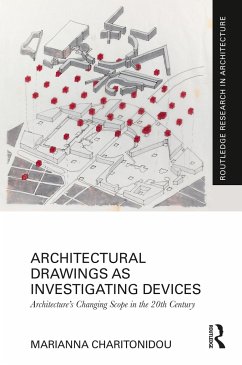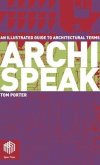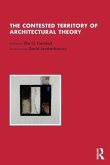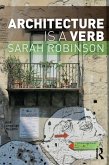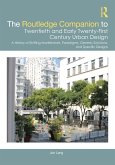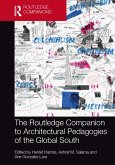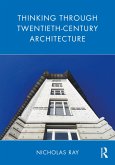Marianna Charitonidou
Architectural Drawings as Investigating Devices
Architecture's Changing Scope in the 20th Century
Marianna Charitonidou
Architectural Drawings as Investigating Devices
Architecture's Changing Scope in the 20th Century
- Gebundenes Buch
- Merkliste
- Auf die Merkliste
- Bewerten Bewerten
- Teilen
- Produkt teilen
- Produkterinnerung
- Produkterinnerung
Architectural Drawings as Investigating Devices explores how the changing modes of representation in architecture and urbanism relate to the transformation of how the addressees of architecture and urbanism are conceived.
Andere Kunden interessierten sich auch für
![Archispeak Archispeak]() Tom PorterArchispeak62,99 €
Tom PorterArchispeak62,99 €![Architecture of Defeat Architecture of Defeat]() Kengo Kuma (Kengo Kuma Architects and Japan Associates)Architecture of Defeat55,99 €
Kengo Kuma (Kengo Kuma Architects and Japan Associates)Architecture of Defeat55,99 €![The Contested Territory of Architectural Theory The Contested Territory of Architectural Theory]() The Contested Territory of Architectural Theory39,99 €
The Contested Territory of Architectural Theory39,99 €![Architecture is a Verb Architecture is a Verb]() Sarah Robinson (Denmark Aalborg University)Architecture is a Verb55,99 €
Sarah Robinson (Denmark Aalborg University)Architecture is a Verb55,99 €![The Routledge Companion to Twentieth and Early Twenty-First Century Urban Design The Routledge Companion to Twentieth and Early Twenty-First Century Urban Design]() Jon LangThe Routledge Companion to Twentieth and Early Twenty-First Century Urban Design278,99 €
Jon LangThe Routledge Companion to Twentieth and Early Twenty-First Century Urban Design278,99 €![The Routledge Companion to Architectural Pedagogies of the Global South The Routledge Companion to Architectural Pedagogies of the Global South]() The Routledge Companion to Architectural Pedagogies of the Global South274,99 €
The Routledge Companion to Architectural Pedagogies of the Global South274,99 €![Thinking Through Twentieth-Century Architecture Thinking Through Twentieth-Century Architecture]() Nicholas Ray (UK University of Liverpool)Thinking Through Twentieth-Century Architecture52,99 €
Nicholas Ray (UK University of Liverpool)Thinking Through Twentieth-Century Architecture52,99 €-
-
-
Architectural Drawings as Investigating Devices explores how the changing modes of representation in architecture and urbanism relate to the transformation of how the addressees of architecture and urbanism are conceived.
Produktdetails
- Produktdetails
- Routledge Research in Architecture
- Verlag: Taylor & Francis Ltd
- Seitenzahl: 270
- Erscheinungstermin: 10. Juli 2023
- Englisch
- Abmessung: 159mm x 243mm x 23mm
- Gewicht: 700g
- ISBN-13: 9781032431109
- ISBN-10: 1032431105
- Artikelnr.: 67514977
- Herstellerkennzeichnung
- Libri GmbH
- Europaallee 1
- 36244 Bad Hersfeld
- gpsr@libri.de
- Routledge Research in Architecture
- Verlag: Taylor & Francis Ltd
- Seitenzahl: 270
- Erscheinungstermin: 10. Juli 2023
- Englisch
- Abmessung: 159mm x 243mm x 23mm
- Gewicht: 700g
- ISBN-13: 9781032431109
- ISBN-10: 1032431105
- Artikelnr.: 67514977
- Herstellerkennzeichnung
- Libri GmbH
- Europaallee 1
- 36244 Bad Hersfeld
- gpsr@libri.de
Dr. Ing. Marianna Charitonidou is Principal Investigator and Postdoctoral Researcher at the Department of Art Theory and History of Athens School of Fine Arts, where she is leading the project Constantinos A. Doxiadis and Adriano Olivetti's Post-war Reconstruction Agendas in Greece and in Italy: Centralising and Decentralising Political Apparatus, and Founder & Principal of Think Through Design Architectural, Urban and Landscape Design Studio. She is architect engineer and urbanist, historian and theorist of architecture and urbanism, expert in sustainable environmental design and curator. Apart from her PhD thesis The Relationship between Interpretation and Elaboration of Architectural Form: Investigating the Mutations of Architecture's Scope (National Technical University of Athens, 2018), she completed the following two postdoctoral projects: The Travelling Architect's Eye: Photography and the Automobile Vision at the Department of Architecture of ETH Zurich, where she was Lecturer (2019-2021), and The Fictional Addressee of Architecture as a Device for Exploring Post-colonial Culture: The Transformations of the Helleno-centric Approaches at the School of Architecture of the National Technical University of Athens. She curated the exhibition The View from the Car: Autopia as a New Perceptual Regime (ETH Zurich, 2021).
Acknowledgments. Foreword by Gevork Hartoonian. Chapter 1. Introduction.
Chapter 2. Different ways of relating fiction to reality and architectural
drawings: Object-oriented and subject-oriented modes of representation.
Chapter 3. Ludwig Mies van der Rohe and Le Corbusier vis-à-vis the
modernist ethos: Around the spirit of truth and clarity. Chapter 4.
Individual-community assemblages in post-war era architecture: The
dissolution of universality. Chapter 5. Decodification of design process as
syntactic analogy: The primacy of the observer in the 1970s & 1980s.
Chapter 6. Identification of the architect with the architectural artefact:
Autobiography vis-à-vis the design process. Chapter 7. Bernard Tschumi and
the intensification of urban conditions: Uncovering the potentialities
hidden in the program. Chapter 8. Bernard Tschumi's architecture as the
discourse of events: Disjunction and a new definition of metropolis.
Chapter 9. Rem Koolhaas and the congestion of metropolis: How the
artificial would replace the reality? Chapter 10. Conversing with Bernard
Tschumi on his conception of architecture's modes of representation:
Instead of epilogue. Index.
Chapter 2. Different ways of relating fiction to reality and architectural
drawings: Object-oriented and subject-oriented modes of representation.
Chapter 3. Ludwig Mies van der Rohe and Le Corbusier vis-à-vis the
modernist ethos: Around the spirit of truth and clarity. Chapter 4.
Individual-community assemblages in post-war era architecture: The
dissolution of universality. Chapter 5. Decodification of design process as
syntactic analogy: The primacy of the observer in the 1970s & 1980s.
Chapter 6. Identification of the architect with the architectural artefact:
Autobiography vis-à-vis the design process. Chapter 7. Bernard Tschumi and
the intensification of urban conditions: Uncovering the potentialities
hidden in the program. Chapter 8. Bernard Tschumi's architecture as the
discourse of events: Disjunction and a new definition of metropolis.
Chapter 9. Rem Koolhaas and the congestion of metropolis: How the
artificial would replace the reality? Chapter 10. Conversing with Bernard
Tschumi on his conception of architecture's modes of representation:
Instead of epilogue. Index.
Acknowledgments. Foreword by Gevork Hartoonian. Chapter 1. Introduction.
Chapter 2. Different ways of relating fiction to reality and architectural
drawings: Object-oriented and subject-oriented modes of representation.
Chapter 3. Ludwig Mies van der Rohe and Le Corbusier vis-à-vis the
modernist ethos: Around the spirit of truth and clarity. Chapter 4.
Individual-community assemblages in post-war era architecture: The
dissolution of universality. Chapter 5. Decodification of design process as
syntactic analogy: The primacy of the observer in the 1970s & 1980s.
Chapter 6. Identification of the architect with the architectural artefact:
Autobiography vis-à-vis the design process. Chapter 7. Bernard Tschumi and
the intensification of urban conditions: Uncovering the potentialities
hidden in the program. Chapter 8. Bernard Tschumi's architecture as the
discourse of events: Disjunction and a new definition of metropolis.
Chapter 9. Rem Koolhaas and the congestion of metropolis: How the
artificial would replace the reality? Chapter 10. Conversing with Bernard
Tschumi on his conception of architecture's modes of representation:
Instead of epilogue. Index.
Chapter 2. Different ways of relating fiction to reality and architectural
drawings: Object-oriented and subject-oriented modes of representation.
Chapter 3. Ludwig Mies van der Rohe and Le Corbusier vis-à-vis the
modernist ethos: Around the spirit of truth and clarity. Chapter 4.
Individual-community assemblages in post-war era architecture: The
dissolution of universality. Chapter 5. Decodification of design process as
syntactic analogy: The primacy of the observer in the 1970s & 1980s.
Chapter 6. Identification of the architect with the architectural artefact:
Autobiography vis-à-vis the design process. Chapter 7. Bernard Tschumi and
the intensification of urban conditions: Uncovering the potentialities
hidden in the program. Chapter 8. Bernard Tschumi's architecture as the
discourse of events: Disjunction and a new definition of metropolis.
Chapter 9. Rem Koolhaas and the congestion of metropolis: How the
artificial would replace the reality? Chapter 10. Conversing with Bernard
Tschumi on his conception of architecture's modes of representation:
Instead of epilogue. Index.

